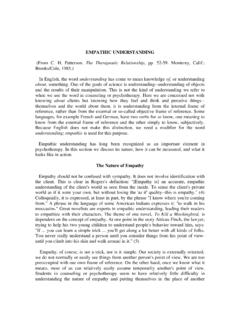Transcription of EMPATHIC UNDERSTANDING - 888-BETSOFF
1 EMPATHIC UNDERSTANDING . (From C. H. Patterson. The Therapeutic Relationship, pp. 52-59. Monterey, Calif.: Brooks/Cole, 1985.). In English, the word UNDERSTANDING has come to mean knowledge of, or UNDERSTANDING about, something. One of the goals of science is UNDERSTANDING -- UNDERSTANDING of objects and the results of their manipulation. This is not the kind of UNDERSTANDING we refer to when we use the word in counseling or psychotherapy. Here we are concerned not with knowing about clients but knowing how they feel and think and perceive things-- themselves and the world about them. it is UNDERSTANDING from the internal frame of reference, rather than from the external or so-called objective frame of reference. Some languages, for example French and German, have two verbs for to know, one meaning to know from the external frame of reference and the other simply to know, subjectively.
2 Because English does not make this distinction, we need a modifier for the word UNDERSTANDING ; EMPATHIC is used for this purpose. EMPATHIC UNDERSTANDING has long been recognized as an important element in psychotherapy. In this section we discuss its nature, how it can be measured, and what it looks like in action. The Nature of Empathy Empathy should not be confused with sympathy. It does not involve identification with the client. This is clear in Rogers's definition: "[Empathy is] an accurate, EMPATHIC UNDERSTANDING of the client's world as seen from the inside. To sense the client's private world as if it were your own, but without losing the 'as if' quality--this is empathy." (4). Colloquially, it is expressed, at least in part, by the phrase "I know where you're coming from." A phrase in the language of some American Indians expresses it: "to walk in his moccasins.
3 " Great novelists are experts in EMPATHIC UNDERSTANDING , leading their readers to empathize with their characters. The theme of one novel, To Kill a Mockingbird, is dependent on the concept of empathy. At one point in the story Atticus Finch, the lawyer, trying to help his two young children to understand people's behavior toward him, says: "If .. you can learn a simple trick .. you'll get along a lot better with all kinds of folks. You never really understand a person until you consider things from his point of view- until you climb into his skin and walk around in it." (5). Empathy, of course, is not a trick, nor is it simple. Our society is externally oriented;. we do not normally or easily see things from another person's point of view. We are too preoccupied with our own frame of reference. On the other hand, once we know what it means, most of us can relatively easily assume temporarily another's point of view.
4 Students in counseling or psychotherapy seem to have relatively little difficulty in UNDERSTANDING the nature of empathy and putting themselves in the place of another person-at least momentarily. It seems that the capacity for empathy is present, to some extent at least, in many people in our society, certainly in most of those who are seriously interested in becoming counselors or psychotherapists. But it is difficult to persist in this frame of reference, since it is not our usual behavior in everyday human relationships. Students easily pop out of the internal into the external frame of reference, and it takes considerable time to overcome the habits of everyday interactions with others. Students are also often bothered by the apparent subjectivity of EMPATHIC UNDERSTANDING . They are obsessed with the need to obtain "objective facts." But the so-called facts are nothing more than the subjective perceptions and impressions of other observers, usually with added evaluative or judgmental aspects.
5 The real "facts" in counseling or psychotherapy are the perceptions, ideas, beliefs, attitudes, and feelings of the client; he or she is the expert on these facts, and the counselor must attempt to see and understand them. The question is sometimes raised regarding discrepancies between the client's perceptions and those of others--shouldn't the counselor check the client's perceptions against those of his or her associates, family, or teachers? If the client's perceptions are greatly out of line with others', this will usually be apparent; often it will be brought to the counselor's attention by those in the client's environment. In cases where the discrepancies are less evident, the counselor will usually become aware of them as counseling continues. The real question is what counselors should or can do about such discrepancies. Usually they should do nothing about them immediately, since there is nothing effective they can do until a relationship is established.
6 When this is achieved, it is likely that the client will recognize, or admit, discrepancies that he or she has been aware of, or will become aware of them, and then therapy can deal with them. Or, if they are apparent, and the client does not seem to be progressing toward awareness of them, the counselor can respond to them through confrontation. (See Chapter 5.). Empathy involves at least three aspects or stages. Assuming that the client is willing to allow the counselor to enter his or her private world and attempts to communicate perceptions and feelings to the counselor, the counselor must be receptive to the communication. Second, counselors must understand the communication of the client. To do this they must be able to put themselves in the place of the client, to take the role of the client. Third, the counselor must be able to communicate his or her UNDERSTANDING to the client.
7 Since, we cannot actually be another person, we are inevitably outside, in an "as if". situation. This is not necessarily a negative situation, but can be positive if we responsively engage in an exploration with the client of his or her perceptions, emotions, and experiences. It is also a protection against too close an identification and against empathy becoming sympathy. "Being EMPATHIC , we assume the role of the other person, and in that role initiate in ourselves the process of self-exploration as if we were the other person himself. (6) In trying to understand clients and in feeling and experiencing with them, we help them in the process of expressing, exploring, and UNDERSTANDING themselves. Differences between counselors and their clients are barriers to empathy. Differences in sex, age, religion, socioeconomic status, education, and culture impede the development of EMPATHIC UNDERSTANDING .
8 Of course, no one can completely understand another person. Everyone is unique, a product of a unique series of experiences. The wider a person's background, the more varied his or her experiences, the greater the UNDERSTANDING of a wider variety of other people. Yet it is impossible for any one individual to have the variety of experiences necessary for UNDERSTANDING all other persons, if identical or similar experiences were necessary for empathy. No male can really experience what it is like to be a female; no White can really experience what it is like to be Black. But it is not necessary for one to be exactly like another or to have had similar experiences to understand another. It may help in UNDERSTANDING a psychotic to have been psychotic oneself, but it is not necessary. We can empathize to some extent at least, and sometimes to a great extent, with any other person on the basis of our commonalities as human beings.
9 As Sullivan put it, "We are all much more simply human than otherwise." (7). Fortunately, it is not necessary that we understand or empathize completely with another to be able to help the other person through relationship therapy. If we are really trying to understand, with at least occasional success in the beginning of therapy, therapy has a chance of continuing and of being successful. Indeed, clients will try to help the therapist understand them and sometimes will show remarkable persistence with an obtuse therapist. It is certainly desirable that counselors should prepare themselves in any way they can to understand potential clients. A counselor who wants to work with a particular age, sex, social, or ethnic group should make some effort to gain an UNDERSTANDING of the particular group. It is frequently recommended that such persons take a course in the social and behavioral sciences, particularly anthropology, for this purpose.
10 However, such courses are not particularly helpful, and they may be harmful. Anthropology is, or strives to be, a science. It is the hallmark of science that it is objective--that is, it studies objects or makes objects out of what it studies. Thus, the approach of anthropology, as it is usually taught, does not lead to a human UNDERSTANDING but to the viewing of other peoples as curious objects, sometimes barely human. To be sure, some anthropologists do develop a deep UNDERSTANDING of the peoples they study, but this is not usually conveyed in an anthropology course. In addition, anthropology is concerned with commonalities of cultures, with groups, rather than with individuals. It thus is in danger of fostering stereotypes, particularly in the minds of students, who are taking only a course or two. Stereotypes are harmful rather than helpful in dealing with or UNDERSTANDING individuals.








